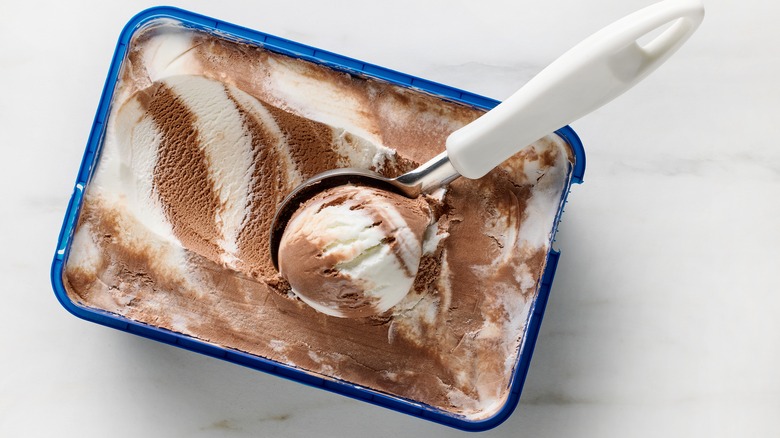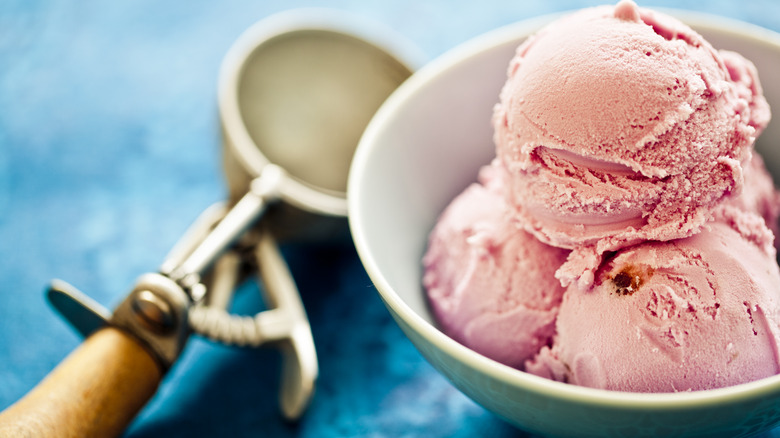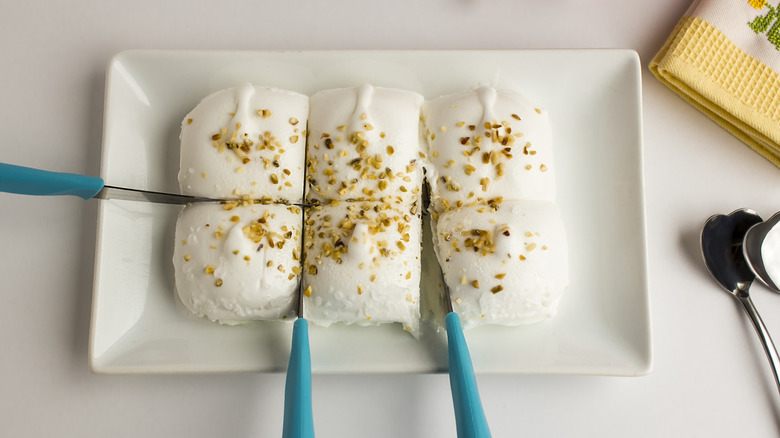The Water Hack For Non-Stick Ice Cream Scooping
There's no doubt that ice cream is one of our favorite treats. The average American eats around four gallons of it every single year, according to the United States Census Bureau. But there's no bigger disappointment than pulling out a tub of premium ice cream from your freezer to find it's rock solid or covered in ice crystals.
While the optimum temperature for a freezer should be around -5 to 0 degrees Fahrenheit, the ideal temperature to serve ice cream is more like 6 to 10 degrees Fahrenheit, according to the International Dairy Foods Association. Softening ice cream a little makes it taste better, enhancing the sweet flavor, and it also makes it easier to scoop.
After all, it's frustrating trying to scoop ice cream that's too hard, whether you just want to eat it straight away, use it for an ice cream sandwich, or prepare a fruity sundae. To make ice cream easier to serve, one great hack is to try dipping your scooper in a bowl of water before each dip into the container. But the key is not to use warm or hot water, as might seem intuitive, but rather to go for cold water.
Use cold water to stop ice cream from sticking to the scooper
Scooping overly hard ice cream isn't just tough on the arm muscles, it also means you often end up with more of the frozen treat stuck on the serving utensil than in your serving bowl. Dipping the scooper in a small bowl of cold water before digging in and between each scoop acts as a lubricant, helping the ice cream to slide off the scoop better.
To try this trick, just dip the scooper in the water and give it a shake before you scoop out the ice cream, so the utensil is damp, but not dripping wet. This helps it to slide across the surface of the ice cream, and prevents the treat from sticking. Using cold water, rather than warm water, also helps to keep the temperature uniform, and stops parts of the ice cream from melting too quickly.
Taking ice cream out of the freezer and letting it thaw slightly on the counter for just a few minutes makes it easier to handle too before you start scooping. Give the tub a gentle squeeze to check if it's ready, and start scooping from the sides, where it's softest. To avoid freezer burnt ice cream, and dreaded ice crystals, you'll want to ensure the treat is not repeatedly softened then re-frozen, so make sure to put it back in the freezer immediately after scooping if you're not planning to eat the entire carton right away.
A knife dipped in water makes non-stick ice cream slices
A metal scooper is easier to use than an ordinary spoon when dishing out ice cream; many professionals prefer a Zeroll, the tool used in American ice cream parlors since 1935. But, if you don't have a scooper, or your ice cream is simply too solid to scoop, or you're just too impatient to wait, you can always try an alternative kitchen utensil instead: a butter knife.
Using a hot knife to cut through hard ice cream is faster than using a scoop, if you're not too worried about having perfectly rounded shapes. Scraping the knife alongside the edge of the bowl also helps remove every last bit of ice cream, so it doesn't stick. Simply run the butter or paring knife under hot water, or dip it into a bowl of hot water, pat it dry, then slice the tub of ice cream into portions.
The knife technique can be used along with a traditional scoop to speed things up, too. Just use the knife first to make a slice and soften the ice cream, then use a scoop to lift out the sections. Or alternatively, if you've got a smaller tub of ice cream, you can cut the whole container in half, peel off the carton, and slice the two blocks into portions for instant, no-fuss ice cream without the wait.



